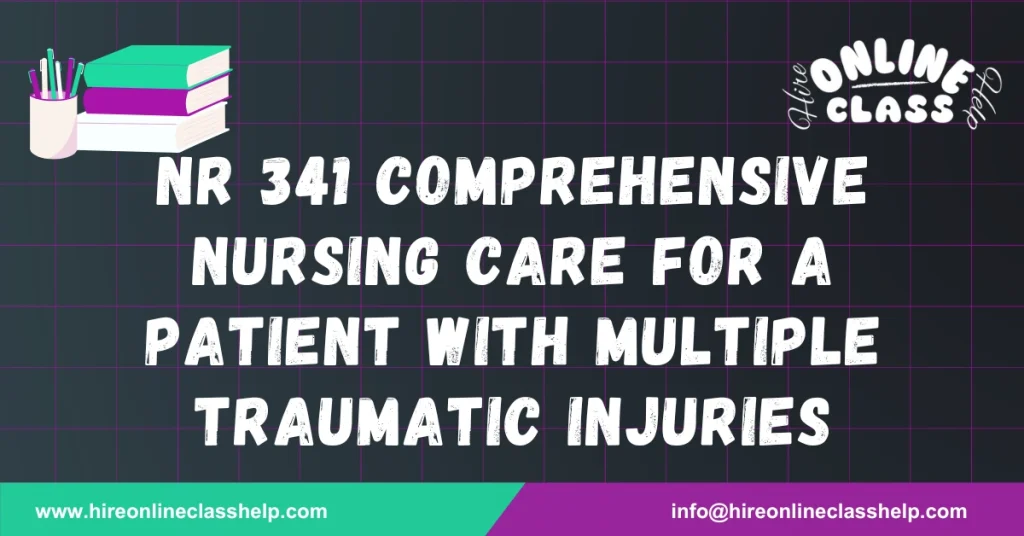






Name
Chamberlain University
NR-341 Complex Adult Health
Prof. Name
Date
This article examines the case of Loius, a 67-year-old Caucasian male who was admitted to the neuro ICU following a motor vehicle accident. Loius sustained multiple injuries, including fractures of the ribs, mandible, and nasal bones, as well as lacerations to his tongue, head, and torso. The primary focus of this article is on Loius’s nursing diagnosis, interventions, collaborative management, therapeutic approaches, and reflections on the nursing role in his care.
Loius’s assessment revealed significant past medical history, including smoking, daily alcohol consumption, and hepatitis C. A notable scar on his back indicated prior back surgery. Upon arrival at the ER, Loius presented with rib fractures, mandibular and nasal fractures, and multiple lacerations as a result of being ejected from his vehicle during the crash. Although his vital signs were relatively stable, Loius exhibited confusion, likely stemming from head trauma. He also experienced significant pain, nasal swelling, and active bleeding.
The nursing diagnoses for Loius included imbalanced nutrition, an ineffective breathing pattern, and a risk for infection. The targeted outcomes were to enhance oral intake, maintain a patent airway, prevent infections, and improve the patient’s overall well-being. Nursing interventions aimed at achieving these outcomes included effective pain management, providing encouragement and support during meals, deep breathing exercises, wound care, and continuous monitoring for signs of infection.
To manage Loius’s pain, a Patient-Controlled Analgesia (PCA) pump was implemented, allowing him to self-administer morphine for optimal pain control. Enteral nutrition was administered to ensure Loius received adequate nutrition for wound healing. Despite his initial reluctance to eat, nursing staff provided encouragement and assistance during mealtimes, aiming to alleviate both anxiety and pain, thus promoting a more comfortable eating experience.
| Nursing Diagnosis | Nursing Interventions | Desired Outcomes |
|---|---|---|
| Imbalanced Nutrition | Enteral nutrition, meal assistance | Improved oral intake |
| Ineffective Breathing Pattern | Deep breathing exercises | Maintenance of a patent airway |
| Risk for Infection | Wound care, infection monitoring | Prevention of infection, improved healing |
Collaborative care for Loius involved a multidisciplinary healthcare team. Occupational therapy helped Loius with assistive devices for eating and drinking, while physical therapy focused on mobility and pain management. Additionally, wound care specialists, surgical services, and nutritional consultations were integral parts of the care plan, ensuring optimal healing and recovery.
Loius’s therapeutic care included interventions to reduce nasal swelling from his fracture and promote tongue wound healing. The use of Peridex solution, an oral antimicrobial rinse, was employed to protect the open wound in his tongue and provide pain relief. These therapeutic modalities played a critical role in enhancing the patient’s comfort and facilitating the healing process.
| Therapeutic Modalities | Purpose |
|---|---|
| Swishing with Peridex solution | Protects open tongue wound, provides pain relief |
| Patient-Controlled Analgesia (PCA) pump | Better pain management |
During the care of Loius, various communication styles were noted, including passive, aggressive, passive-aggressive, and assertive. Among these, assertive communication proved to be the most effective in fostering open dialogue, promoting teamwork, and ultimately enhancing patient outcomes. The case highlighted the challenges of caring for comatose patients, emphasizing the importance of empathetic and compassionate care.
Additionally, teamwork among nursing staff played a vital role in delivering high-quality care. Collaboration between senior nurses, healthcare professionals, and support staff facilitated optimal patient care. One recommendation for improvement involved increasing the availability of lifts on the floor to improve the safety of both patients and nursing staff during transport.
| Reflection Area | Observations and Recommendations |
|---|---|
| Communication Styles | Assertive communication improved patient outcomes |
| Teamwork | Collaboration between staff enhanced care quality |
| Safety Recommendation | Increasing the availability of lifts to enhance patient transportation safety |
Loius’s case underscores the significance of comprehensive nursing care, collaboration, and communication in achieving positive patient outcomes. The nursing diagnoses, interventions, collaborative management, and therapeutic approaches applied in this case provide valuable insights for future practice. By prioritizing assertive communication, teamwork, and patient-centered care, nurses can play a crucial role in improving patient outcomes.